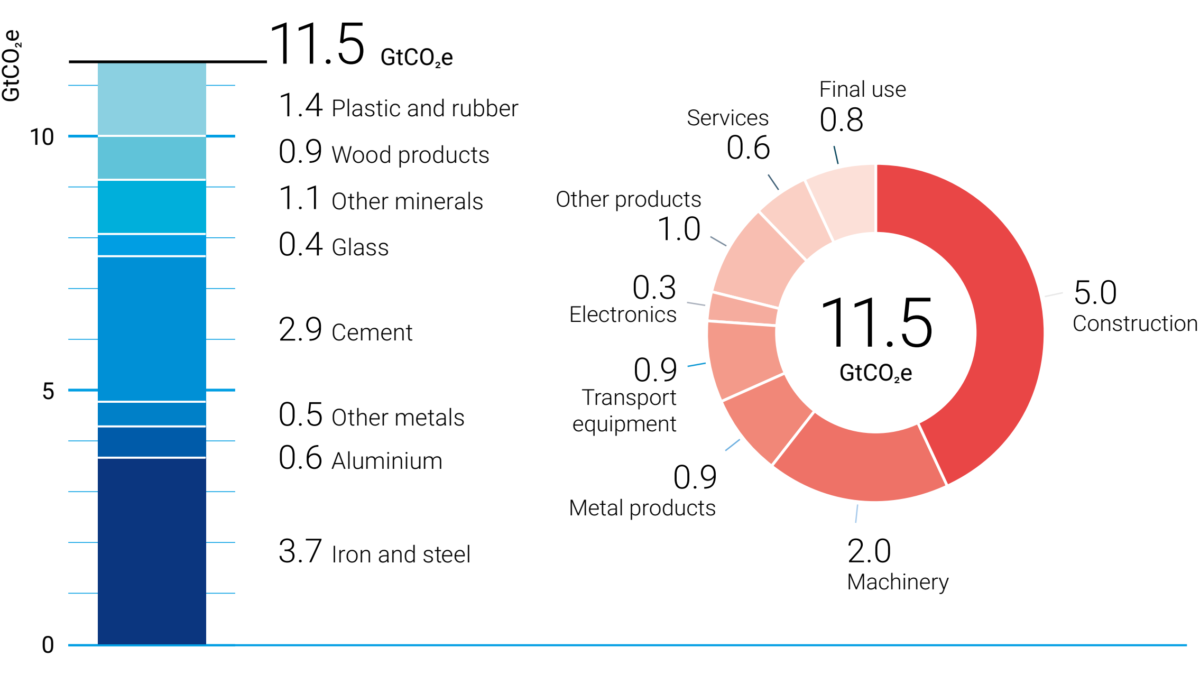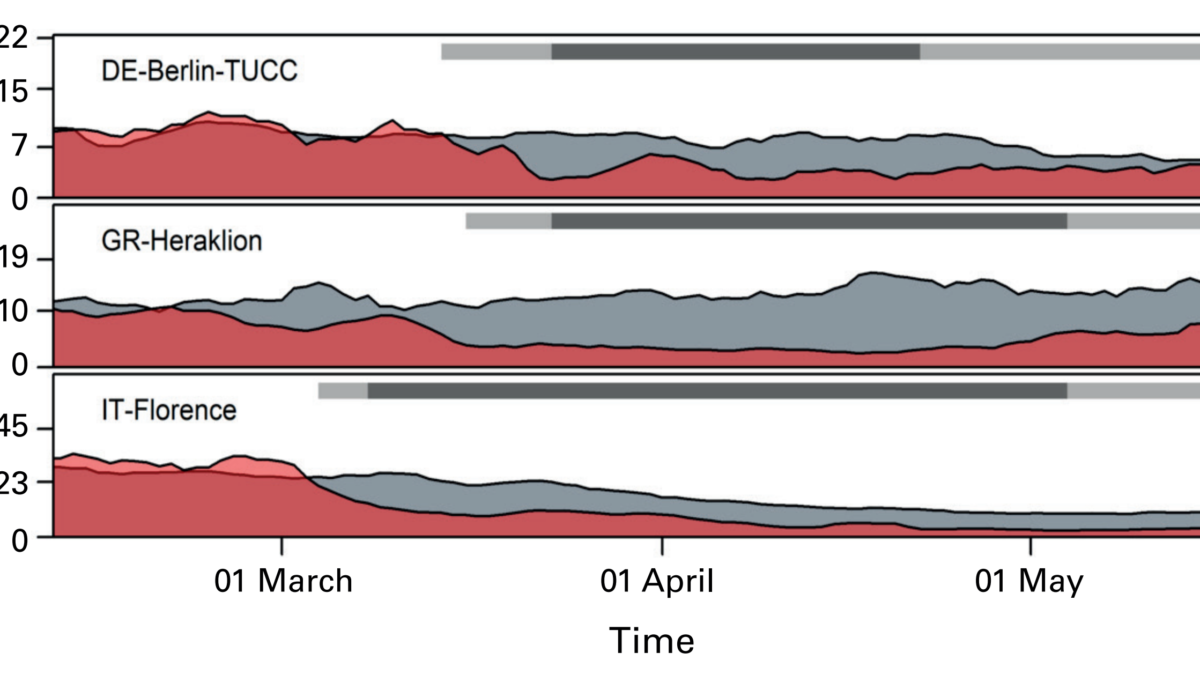U.S. life expectancy drops by a full year due to COVID-19 and fentanyl overdose deaths – Toll on minority communities is significantly more deadly – “We haven’t seen a decline of this magnitude in decades”
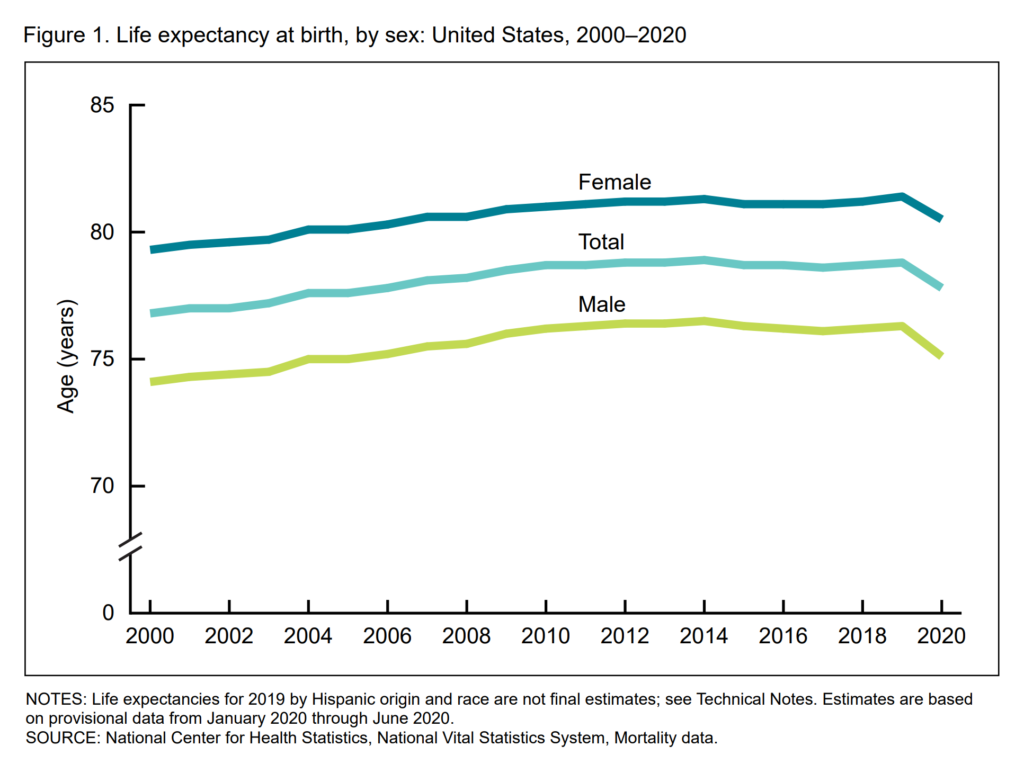
By Sabrina Tavernise and Abby Goodnough
18 February 2021
(The New York Times) – Life expectancy in the United States fell by a full year in the first six months of 2020, the federal government reported on Thursday, the largest drop since World War II and a grim measure of the deadly consequences of the coronavirus pandemic.
Life expectancy is the most basic measure of the health of a population, and the stark decline over such a short period is highly unusual and a signal of deep distress. The drop comes after a troubling series of smaller declines driven largely by a surge in drug overdose deaths. A fragile recovery over the past two years has now been wiped out.
Thursday’s data gives the first full picture of the pandemic’s effect on American expected life spans, which dropped to 77.8 years from 78.8 years in 2019. It also showed a deepening of racial and ethnic disparities: Life expectancy of the Black population declined by 2.7 years in the first half of 2020, slicing away 20 years of gains. The life expectancy gap between Black and white Americans, which had been narrowing, is now at six years, the widest it has been since 1998.
“I knew it was going to be large but when I saw those numbers, I was like, ‘Oh my God,’” Elizabeth Arias, the federal researcher who produced the report, said of the racial disparity. Of the drop for the full population, she said, “We haven’t seen a decline of that magnitude in decades.” […]
Dr. Mary T. Bassett, a former New York City health commissioner and professor of health and human rights at Harvard University, said that unless the country better addressed inequality, “we may see U.S. life expectancy stagnate or decline for some time to come.”
She noted that life expectancy in America began to lag behind that of other developed countries in the 1980s, a divergence that has puzzled researchers. One theory is that growing economic disparities have also made their way into the health of Americans. Life conditions that have led to worse Covid-19 rates, such as overcrowded housing and inadequate virus protections for low-wage workers, will only exacerbate that trend, Dr. Bassett said. [more]
A Grim Measure of Covid’s Toll: Life Expectancy Drops Sharply in U.S.
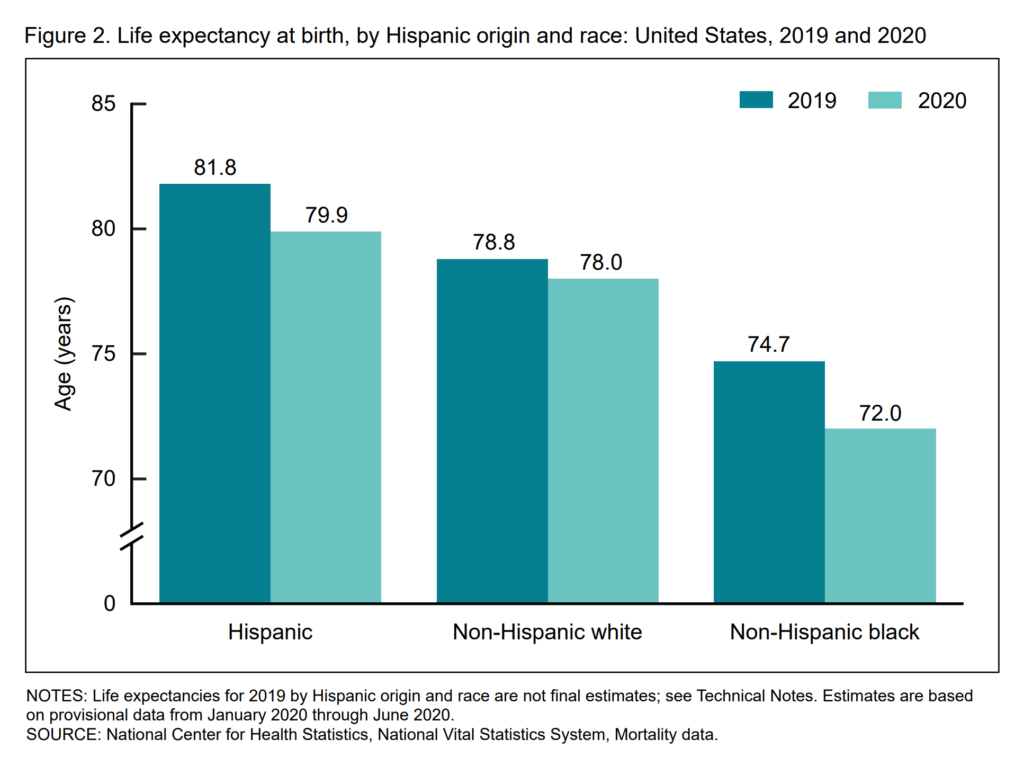
New Data Show the Pandemic Has Slashed Black and Brown Life Expectancy
By Paola Rosa-Acquino
18 February 2021
(Intelligencer) – As the coronavirus ravaged the nation, life expectancy in the United States plunged by one full year during the first half of 2020, according to a new Centers of Disease Control and Prevention report released Thursday. Minority communities suffered by far the biggest impact.
Life expectancy, defined by how long a baby born today can expect to live on average, dropped from 78.8 years last year to 77.8 during the first six months of 2020 for which the CDC has data. It’s the largest decline in life expectancy in the United States since World War II.
But when this toll is broken down by race and ethnicity, stark differences emerge. For Black people, the average lifespan will shrink by nearly three years, while Latinos will see their life expectancy reduced by two. The expected lifespan of white Americans dropped 0.8 years, to 78. (The CDC’s initial data did not report the change in life expectancy among Asian Americans or Native Americans.)
“We’re living in a global pandemic in which we know many people have died, so it is not unexpected to see a decline in life expectancy,” says Kirsten Bibbins-Domingo, the vice-dean of population health and health equity at UC San Francisco. “What is surprising is to see the magnitude of the effect with just six months of data.”
The historic race gap between white and Black lifespans in the U.S had been shrinking in recent years, but these latest figures have reversed some of that progress. Now, that gap is at six years — the widest it has been since 1998. […]
But the virus wasn’t the only factor behind the change. According to the report, the numbers also reveal the impact the pandemic has had on society at large: A surge in drug-overdose deaths and in people dying from other health problems, such as heart disease and cancer, is part of the decline too.
The latest CDC data account for only the first six months of 2020, which, the report notes, “do not reflect the entirety of the effects of the COVID-19 pandemic in 2020.” That means the decline in life expectancy will likely fall even further because the pandemic turned more deadly as the year wore on. “These numbers are going to get worse,” says Bibbins-Domingo. “That is a certainty.” [more]
New Data Show the Pandemic Has Slashed Black and Brown Life Expectancy
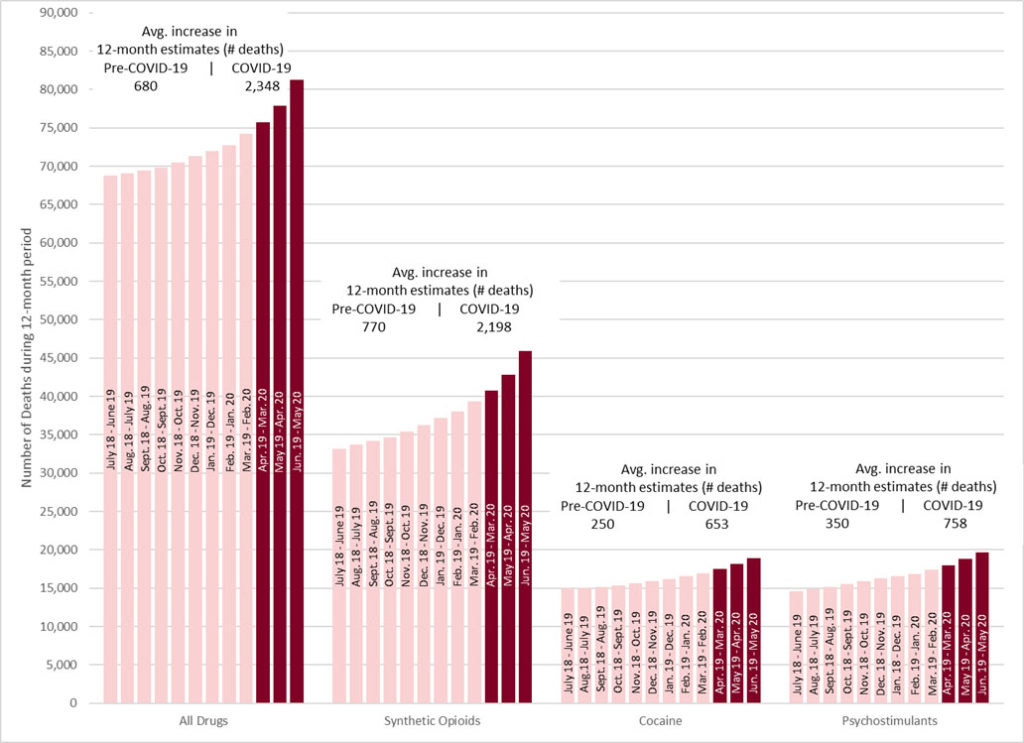
Increase in Fatal Drug Overdoses Across the United States Driven by Synthetic Opioids Before and During the COVID-19 Pandemic
17 December 2020 (CDC) – The purpose of this Health Alert Network (HAN) Advisory is to alert public health departments, healthcare professionals, first responders, harm reduction organizations, laboratories, and medical examiners and coroners to—
- substantial increases in drug overdose deaths across the United States, primarily driven by rapid increases in overdose deaths involving synthetic opioids excluding methadone (hereafter referred to as synthetic opioids), likely illicitly manufactured fentanyl;
- a concerning acceleration of the increase in drug overdose deaths, with the largest increase recorded from March 2020 to May 2020, coinciding with the implementation of widespread mitigation measures for the COVID-19 pandemic;
- the changing geographic distribution of overdose deaths involving synthetic opioids, with the largest percentage increases occurring in states in the western United States;
- significant increases in overdose deaths involving psychostimulants with abuse potential (hereafter referred to as psychostimulants) such as methamphetamine; and
- recommendations for communities when responding to the evolving overdose crisis.
Background
The most recent provisional data available from the Centers for Disease Control and Prevention’s (CDC) National Center for Health Statistics (NCHS) indicate that approximately 81,230 drug overdose deaths occurred in the United States in the 12-months ending in May 2020 (Figure 1).i This represents a worsening of the drug overdose epidemic in the United States and is the largest number of drug overdoses for a 12-month period ever recorded.1 After declining 4.1% from 2017 to 2018,2 the number of overdose deaths increased 18.2% from the 12-months ending in June 2019ii to the 12-months ending in May 2020 (Figure 1).3 Drug overdose deaths during this time increased more than 20% in 25 states and the District of Columbia, 10% to 19% in 11 states and New York City, and 0% to 9% in 10 states. Drug overdose deaths decreased in four states (Figure 2).
The recent increase in drug overdose mortality began in 2019 and continues into 2020, prior to the declaration of the COVID-19 National Emergency in the United States in March. The increases in drug overdose deaths appear to have accelerated during the COVID-19 pandemic. Provisional overdose death estimates indicate that the largest monthly increases in drug overdose deaths occurred in the 12-months ending in February 2020 (74,185 deaths) and the 12-months ending in March 2020 (75,696 deaths), the 12-months ending in March 2020 (75,696 deaths) to the 12-months ending in April 2020 (77,842 deaths), and from the 12-months ending in April 2020 (77,842 deaths) to the 12-months ending in May 2020 (81,230 deaths). These one-month increases of 2,146 deaths and 3,388 deaths, respectively for the 12-month periods (Figure 1), are the largest monthly increases documented since provisional 12-month estimates began to be calculated in January 2015.3

Synthetic opioids are the primary driver of the increases in overdose deaths. The 12-month count of synthetic opioid deaths increased 38.4% from the 12-months ending in June 2019 compared with the 12-months ending in May 2020 (Figure 1). Of the 38 jurisdictions with available synthetic opioid data,3 37 jurisdictions reported increases in synthetic opioid overdose deaths for this time period. Eighteen of these jurisdictions reported increases greater than 50%, 11 reported increases of 25% to 49%, 7 reported increases of 10% to 24%, 1 reported an increase <10% (See Figure 3). State and local health department reports indicate that the increase in synthetic opioid-involved overdoses is primarily linked to illicitly manufactured fentanyl.4-6 Historically, deaths involving illicitly manufactured fentanyl have been concentrated in the 28 states east of the Mississippi River, where the heroin market has primarily been dominated by white powder heroin.5,7 In contrast, the largest increases in synthetic opioid deaths from the 12-months ending in June 2019 to the 12-months ending in May 2020 occurred in 10 western states (98.0% increase).iii This is consistent with large increases in illicitly manufactured fentanyl availability in western states8 and increases in fentanyl positivity in clinical toxicology drugs tests in the West after the COVID-19 pandemic.9 Increases in synthetic opioid overdose deaths were also substantial in other regions: 12 southern states and the District of Columbia (35.4%), 6 midwestern states (32.1%), and 8 northeastern states and New York City (21.1%) (Figure 3). [more]

